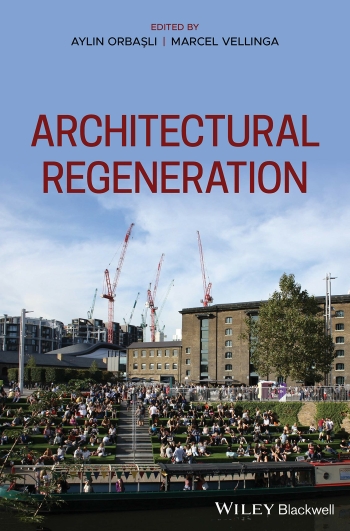Architectural Regeneration
Architectural Regeneration, Edited by Aylin Orbasli and Marcel Vellinga, Wiley Blackwell, 2020, 348 pages, several photographs (most in colour) and illustrations.
Almost every IHBC member must be involved in the process of architectural regeneration or at least have an interest in it, due to the very purpose of the institute. This book will thus have value to all members. It provides a comprehensive and detailed overview of the evolution and process of regeneration, conservation, rehabilitation and revitalisation of architectural heritage.
Many of us may know architectural regeneration as ‘adaptive re-use’ but the authors see it as a wider activity, ‘…the collective activities of re-using, adapting and evolving existing buildings… underpinned by the principles of environmental, social and cultural sustainability’. Accordingly, the book grapples, in an even-handed way, with area-based regeneration, placemaking, the historic urban landscape approach; and the perennial thorny issues of significance, facadism, authenticity and whether interventions, extensions and new build should be traditional or not, among others.
Architectural Regeneration is not so much a guide to best practice nor a gazetteer of successful projects, although it does cross-reference examples from around the world. Nor is it, as such, an advocate for architectural regeneration over redevelopment or decay (curated or not), although the environmental, economic, intangible, cultural and social benefits are clearly articulated. It is first and foremost an academic study of the many political, social, cultural, financial and practical factors that have influenced the evolution of the process of architectural regeneration. It examines how the combined processes of globalisation, urbanisation, environmental change, changing cultural values, population growth and rapid technological development have resulted in an increasingly complex, dynamic and inter-related world. It looks in detail at how these factors have played a part in the conceptualisation, implementation and perception of the conservation of (not necessarily) historic buildings.
As an academic study, it is aimed primarily at students of architecture, building conservation, urban and environmental design, sustainability, and urban regeneration, who can use it as a reference to gain an understanding of how the conservation movement and the related professions have got us to where we are today. All 16 contributors hold, or have held, academic teaching positions at universities, so it is perhaps not surprising that the text’s value is enhanced for readers by extensive bibliographies and suggestions for further reading at the end of each chapter. Assertions about causality and effect, analysis, hypotheses and theories are also cross-referenced to their originators. Many of the contributors have also been, or still are, practitioners and so have been able to alloy practical experience with high-level understanding.
The photographs and illustrations provide some relief, but the book is not an easy read. Even so, hardworking members of the institute, who are under pressure to complete their next committee report, heritage statement or repair methodology to meet their employer’s or clients’ deadlines, would benefit by stepping back from time to time to read this book, and reassess their daily toil with a better understanding of the historical and international context in which they work.
In addition to the theorising, the book provides three specific case studies, from Oxford, Istanbul and Portugal, by contributors who were directly involved in the projects. In the former, Geoffrey Randall examines the conversion of Oxford Castle and Prison into a hotel. He rightly acknowledges its success, commercially and professionally, although some might query whether the enlargement of the prison windows sensitively ‘retains the prison’s austerity’, as he contends.
As well as editing, the contributions Orbasli and Vellinga make lucid contributions, individually and in collaboration. Indeed, their opening chapter, Architectural Regeneration and its Theoretical Context, effectively provides an executive summary of the book’s content, and might be sufficient for those with a limited attention span or lack of time.
This article originally appeared as ‘A matter of context’ in Context 169, published by the Institute of Historic Building Conservation (IHBC) in September 2021. It was written by John Hinchliffe, heritage consultant.
--Institute of Historic Building Conservation
Related articles on Designing Buildings
IHBC NewsBlog
Purcell’s guidance on RAAC for Listed Buildings in England & Wales
The guidance specifically focuses on Reinforced Autoclaved Aerated Concrete (RAAC) in listed buildings.
IHBC Membership Journal Context - Latest Issue on 'Hadrian's Wall' Published
The issue includes takes on the wall 'end-to-end' including 'the man who saved it'.
Heritage Building Retrofit Toolkit developed by City of London and Purcell
The toolkit is designed to provide clear and actionable guidance for owners, occupiers and caretakers of historic and listed buildings.
70 countries sign Declaration de Chaillot at Buildings & Climate Global Forum
The declaration is a foundational document enabling progress towards a ‘rapid, fair, and effective transition of the buildings sector’
Bookings open for IHBC Annual School 12-15 June 2024
Theme: Place and Building Care - Finance, Policy and People in Conservation Practice
Rare Sliding Canal Bridge in the UK gets a Major Update
A moveable rail bridge over the Stainforth and Keadby Canal in the Midlands in England has been completely overhauled.
'Restoration and Renewal: Developing the strategic case' Published
The House of Commons Library has published the research briefing, outlining the different options for the Palace of Westminster.
Brum’s Broad Street skyscraper plans approved with unusual rule for residents
A report by a council officer says that the development would provide for a mix of accommodation in a ‘high quality, secure environment...
English Housing Survey 2022 to 2023
Initial findings from the English Housing Survey 2022 to 2023 have been published.
Audit Wales research report: Sustainable development?
A new report from Audit Wales examines how Welsh Councils are supporting repurposing and regeneration of vacant properties and brownfield sites.

















